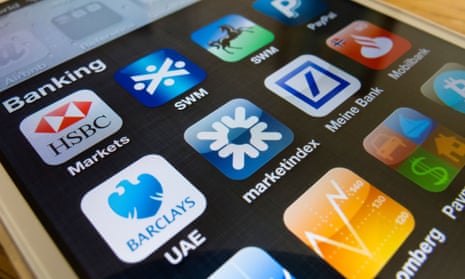Smartphone-addicted Britons are embracing mobile banking, with payments via apps rocketing 54% in 2015 and reaching a value of £347m.
The average customer of certain UK banks views their finances on their phone more than once a day – and much of this balance checking and payment making is done while people watch TV, according to a report by the British Bankers’ Association.
The average branch in the high street deals with only 71 customer visits a day – a 32% decline since 2011 – as consumers switch to online methods of managing money, the BBA says.
Customers use banking apps more than 7,610 times a minute – or 4bn times a year. Some of these services do a lot more than allow users to check their account balance or make payments. Atom, one of the new breed of digital banks, offers an app with a display that changes colour if the customer’s finances are in good health but starts to “throb” if there is something they need to attend to that will cost them money.
Royal Bank of Scotland upgraded its app this year to allow customers to apply for a personal loan or credit card or manage an overdraft while on the move. Apps are increasingly preferred to banks’ websites, according to BBA figures, noting that internet banking logins fell in number slightly last year.
The big loser from this latest digital revolution appears to be high-street branches. The average number of visits is projected to fall to only 51 a day within five years. More than 680 UK bank branches closed last year, on top of the 512 that went in 2014, according to the Campaign for Community Banking Services.
The BBA report said customers were the biggest winners from the “consumer-led revolution” but such claims could fuel concerns of the technology being used to justify further branch closures. Campaigners said more closures would affect vulnerable customers and regular users of branch counters, such as traders and voluntary groups.
Derek French, director of the campaign group, said: “We have no problem with further digitisation, we welcome it. Where we are concerned is that the closure of branches is proceeding at a faster pace than any alternatives that are being put in place to assist vulnerable customers and others.”
The report points to a “staggering” increase in people using mobile apps, which it said proved that it was “now easier than ever to interact with your bank”.
More than 40,000 of these mobile applications were downloaded a day in 2015 – up 25% on the year before – while the number of logins to banking apps leapt 50% to reach almost 11m a day.

“Anyone who doubts just how much mobile banking has become part of the daily routine for millions of us should consider just how frequently customers login to their apps. Some BBA members have reported that the average customer now logs in to check their balance or make a payment 36 times a month,” the report says.
The technology was making it easier to squeeze routine banking tasks into busy lives. “Many financial chores that traditionally had to be done by trudging off to the nearest high-street branch can now be done without taking a step out of your way.” Checking an account balance via a mobile app might take three seconds rather than the 30 seconds necessary to log in to internet banking.
Research by TSB found that 45% of mobile or internet banking was carried out while the customers were in front of a TV; about 18% was done at work, 17% in bed and 11% while commuting.
However, it seems that when it comes to more complex transactions, many people still prefer the personal touch provided by a bank branch, or at the very least, online banking via a computer.
George Charalambous, head of digital transformation at HSBC retail banking, said to the report’s authors: “Would I, as a customer, expect to complete a mortgage application end-to-end on my mobile? Maybe I wouldn’t, maybe that’s something I want to do in the privacy of my home, on a laptop or desktop.”
The report highlights data estimates showing that the number of visits to bank branches has fallen, from 476m in 2011 to 278m in 2016.
The BBA attempted to reassure those who might be concerned, saying that few bank experts believed the mobile app would “sound the death knell” for bank branches. And some banks were continuing to keep the faith: the relative newcomer Metro Bank is on Friday opening its 42nd outlet, in Bexleyheath, south-east London.

Comments (…)
Sign in or create your Guardian account to join the discussion